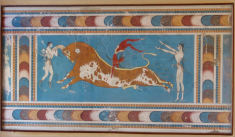Speakers
Description
I will present a new strategy [1] to analyze the chemical freeze-out of light (anti)nuclei produced in high energy collisions of heavy atomic nuclei within an advanced version of the hadron resonance gas model. It is based on two different, but complementary approaches to model the hard-core repulsion between the light nuclei and hadrons. The first approach is based on an approximate treatment of the equivalent hard-core radius of a roomy nuclear cluster and pions, while the second approach is rigorously derived here using a self-consistent treatment of classical excluded volumes of light (anti)nuclei and hadrons.
By construction, in a hadronic medium dominated by pions, both approaches should give the same results.
Employing this strategy to the analysis of hadronic and light (anti)nuclei multiplicities measured by ALICE at
$\sqrt{s_{NN}} =2.76$ TeV and by STAR at $\sqrt{s_{NN}} =200$ GeV, we got rid of the existing ambiguity in the description of light (anti)nuclei data and determined the chemical freeze-out parameters of nuclei with high accuracy and confidence.
Using this strategy we were able to resolve the long standing problem to describe the light nuclear cluster multiplicities including the hyper-triton measured by the STAR Collaboration, known as the hyper-triton chemical freeze-out puzzle [2]. It solution was found by using the value for the hard-core radius of the (anti-)$\Lambda$ hyperons which was found in our earlier works. One of the most striking results of our work [2] is that for the most probable scenario of chemical freeze-out for the STAR energy the obtained parameters allow to simultaneously reproduce the values of the experimental ratios $S_3$ and $\overline{S}_3$ which were not included in the fit. In addition we were able to elucidate some peculiar properties of the QGP bags at STAR and ALICE energies of collisions.
References
[1] K. A. Bugaev, O. V. Vitiuk, B. E. Grinyuk, V. V. Sagun, N. S. Yakovenko, O. I. Ivanytskyi, G. M. Zinovjev, D. B. Blaschke, E. G. Nikonov, L. V. Bravina, E. E. Zabrodin, S. Kabana, S. V. Kuleshov, G. R. Farrar, E. S. Zherebtsova and A. V. Taranenko,
Second virial coefficients of light nuclear clusters and their chemical freeze-out in nuclear collisions,
arXiv:2005.01555 [nucl-th].
[2] O. V. Vitiuk, K. A. Bugaev, E. S. Zherebtsova, D. B. Blaschke, L. V. Bravina, E. E. Zabrodin and G. M. Zinovjev,
Resolution of hyper-triton chemical freeze-out puzzle in high energy nuclear collisions,
arXiv:2007.07376 [hep-ph].
Details
Prof. Kyrill Bugaev, Bogolyubov Institute for Theoretical Physics, Kyiv, Ukraine
| Is this abstract from experiment? | No |
|---|---|
| Name of experiment and experimental site | N/A |
| Is the speaker for that presentation defined? | Yes |
